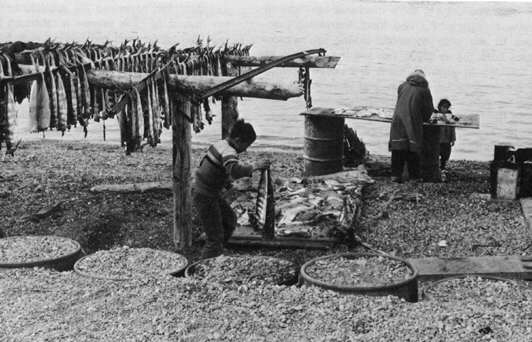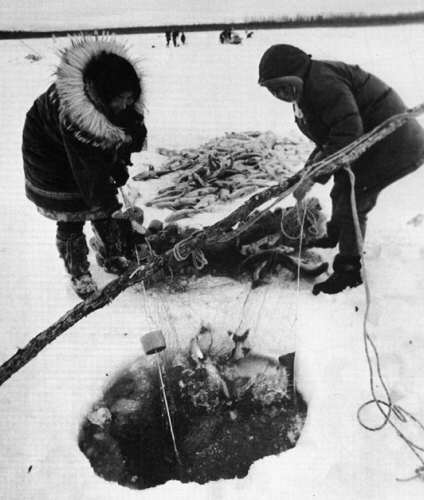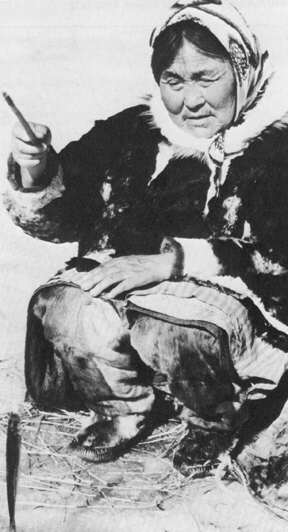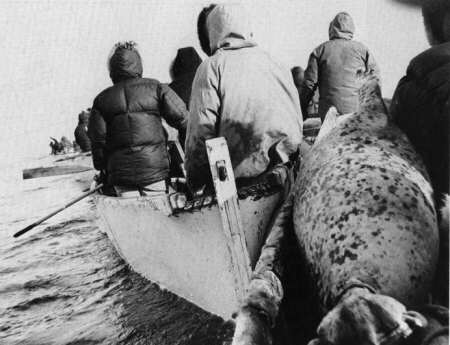Utilization of Biotic Resources
Aquatic Animals
Village life in the Northwest Region still revolves around hunting and fishing
for marine animals along the coast and for freshwater fish along inland rivers,
particularly the Noatak, Kobuk, and Selawik.
Subsistence
Invertebrates and Fish—Subsistence use of invertebrates and fish in
this region has declined in recent years for a number of reasons. The shift
from sled dogs to snow machines has reduced the number of salmon required for
dog food. Increasing year-round employment in the cash economy during the salmon
season has decreased both the ability to fish and the necessity of large subsistence
harvests. In addition, many areas have recently developed substantial commercial
fisheries, and there has been a shift from reliance on subsistence to participation
in the commercial fishery. The five species of Pacific salmon are the major
subsistence fish in the region, and the total take of these species for the
period 1963-72 is shown in Figure 143.
In the Norton Sound district (Alaska Department of Fish and Game designation)
most subsistence fishing is done in the lower portion of rivers emptying into
salt water. Generally, short gill nets are fished in these rivers, although
a few beach seines may also be used. Fish may supply up to 40 percent of the
year's food requirements for a typical household in this district with salmon
the most important, recently up to 200,000 taken annually for subsistence. Chum
and pink salmon provide the majority of the harvest, although in the Unalakleet
subdistrict silvers and kings are taken in significant numbers. Very few red
salmon are caught for subsistence here. This harvest is supplemented by Arctic
grayling, herring, smelt, burbot, Arctic char, and whitefish.
In the Port Clarence district, residents of Teller and Brevig Mission fish
Grantley Harbor and Tuksuk Channel. Nome residents travel to this district to
fish Pilgrim River and Salmon Lake. Chum, red, and pink salmon are the most
important species harvested. A small number of silver salmon are irregularly
taken, and very few kings are ever harvested. Total annual subsistence harvest
of salmon in recent years has averaged slightly under 5,000 fish.
In the Kotzebue district a salmon spear and nets dating to 1250 A.D. have been
found near the Kobuk River, documenting a long history of subsistence use. Chum
salmon are the most abundant fish harvested for subsistence in this region today.
A fair harvest of pink salmon is taken on the Noatak River and a few king, silver,
and red salmon may be taken incidentally. At Noatak, the pink salmon arrive
in early to mid-July when they are the major species fished. Later in August,
the chum run begins and reaches a peak during the second or third week of September,
after which it continues to decline through freezeup of the river. High water
tends to reduce the salmon subsistence harvest, and if the salmon catch is low,
fishermen may shift their attention to other areas or to other species. They
may fish for Arctic char in the Noatak system or inconnu in the Hotham Inlet-Selawik
Lake area during winter and early spring (Foote and Williamson 1966). Noatak
residents may also fish the Wulik River for char. In recent years the total
subsistence harvest of chum salmon in this district has averaged slightly over
20,000 fish.
lnconnu are harvested in the Kobuk delta-Hotham Inlet-Selawik Lake area. These
fish are taken by gill net in the upper Kobuk River and by jigging through the
ice on Hotham Inlet in winter and early spring. The Arctic char is an important
subsistence fish for several villages. These fish may be caught any time during
the year except in late July and early August when they are in offshore marine
areas.
Figure 143. Total Subsistence Harvest of Salmon,
1963-1972
A large, well-studied, subsistence fishery for Arctic char is conducted by
the residents of Kivalina on the Wulik River. In spring, these fish are caught
during their out-migration to the ocean with gill nets and by angling. In late
August to mid-September, the in-migrating adults are intercepted on their return
to fresh water, again by means of gill nets in the coastal lagoons and lower
Wulik River and seines in the lower and upper Wulik River. Arctic char are caught
as they migrate in schools along the coast past Point Hope. In some years, significant
numbers of whitefish are also taken from rivers in this district.
Other minor freshwater species caught are smelt, Arctic grayling, burbot, and
northern pike. Offshore subsistence fishing, usually by angling through the
ice in winter, yields a harvest of herring, crab, and Arctic cod. In some years,
Arctic cod may be abundant in lagoons where they are caught by beach seine in
early July and late August. The extent of dependence on these species for subsistence
is indicated by the 1959 catches of 85,600 pounds of Arctic char and 12,000
pounds of whitefish recorded by Saario and Kessel (1966) in Kivalina.
|
 Bottom
Left: Inconnu and other whitefish are harvested at Ambler on the Kobuk
River. Bottom
Left: Inconnu and other whitefish are harvested at Ambler on the Kobuk
River.
Right: Many chum salmon are harvested annually in the Kotzebue
area for subsistence. These fish are gutted, split, and hung to air dry
on racks along the shores of Kotzebue Sound and Hotham Inlet. Inconnu
are prepared in a similar manner.
Bottom right: Winter diets are often supplemented by catches of
smaller fish taken through the ice from nearshore waters.
|
 |

|
Marine Mammals and Birds—Marine mammals are important to subsistence
for many residents of the region. The people of Point Hope, Wales, Diomede,
King Island, Gambell, and Savoonga are strategically located to intercept marine
mammals of various species during their migration and have developed life-styles
and economies accordingly.
Point Hope, Gambell, and Savoonga normally take baleen whales, usually bowheads.
Kivalina sometimes takes whales, but residents of that and other nearby villages
more often join Point Hope whaling crews. Not only do the whales taken (usually
four or more a season at Point Hope) provide a substantial amount of food, but
whaling is a major focal point of the annual community cycle of activity, and
status in the village depends to a large extent on whaling. Presently, fewer
whales are taken at Gambell and Savoonga. Belugas are taken in large numbers
and with less ceremony at coastal communities in Kotzebue Sound from Point Hope
to Deering and in Norton Sound from Nome to Stebbins. Walrus, bearded seals,
and the smaller ringed and harbor seals are the mainstay of subsistence in the
Bering Strait-St. Lawrence Island area. Fewer walrus are taken in the Point
Hope-Kivalina area, but residents there use many seals. The umiak, a skin-covered
boat used in both subregions, is normally covered with walrus hide in the Norton
Sound and bearded seal skins in Kotzebue Sound.
Polar bears may be taken incidentally to other hunting at Point Hope, Kivalina,
and the Bering Strait-St. Lawrence Island area. Although these bears are not
a major item of subsistence, they have become more available to residents of
the coastal communities following the ban on hunting them from aircraft.
Aquatic birds are also important for subsistence. Sea ducks, mainly eiders,
are taken at most of the coastal communities, often in connection with marine
mammal hunting. Brant are also important to several communities that lie on
their migration route. Murres, puffins, auklets, and their eggs are a common
subsistence resource mainly at Point Hope, Kivalina, and Bering Strait villages.
Freshwater birds, mainly geese, ducks, and cranes, are most important to communities
adjacent to extensive marsh lands and villages along the Kobuk River. Beaver,
muskrat, mink, and river otters are also used for subsistence where they occur.
| [insert picture from p. 174] |
Little Diomede. Proceeds of the walrus hunt are
often divided up on a nearby shore or ice floe. |
| [insert picture from p. 174] |

Above: Inflated seal skin "poke" is used as float and
marker and is attached to dead whale.
Left: Gambell boys eat muktuk while standing on whale baleen.
|
Commercial
Fish—Salmon have been the mainstay of the small commercial fishery of the Northwest
Region, although other species are taken. Salmon harvests for recent years are
shown in Figure 144. Commercial fishing began initially in the Norton Sound
district in 1917 when the Arctic Fish Company operated a scow in Golovin Bay
(Cobb 1931). Some salted salmon was produced early in this century at Nome and
St. Michael. Little additional development occurred until 1961 when the Alaska
Department of Fish and Game opened the Shaktoolik and Unalakleet subdistricts
to salmon fishing. Early catches were composed of king and silver salmon which
were dressed and flown to Anchorage. In 1961 a freezer ship was available locally
to process chum and pink salmon. In 1962 the additional subdistricts of Norton
Bay, Moses Point, and Golovin Bay were opened to commercial fishing, and two
floating cannery ships operated in the area. In 1964 the Nome subdistrict was
opened to commercial fishing.
Recent commercial fishing activity in this district has been sporadic due to
a lack of processors and buyers and inadequate tendering service to collect
fish from fisherman. Processing is minimal—a few shore-based freezing and salting
plants. Most fishing occurs in Norton Sound near stream mouths. Normally, the
first salmon landings are in mid-June, and fishing continues until processors
terminate the season in August. Fishermen operate 15- to 20-foot outboard skiffs
and fish set gill nets. Three-quarters of the commercial catch in the district
is chum salmon, with pink salmon making up almost all the remainder. Several
thousand silver and king salmon complete the annual commercial harvest. Between
1923 and 1941, a small commercial fishery harvested herring in Golovin Bay (Anderson
and Carlson 1945).
A small commercial fishery for salmon took place in the Port Clarence district
in 1966. No further commercial harvest has been recorded.
From 1914 to 1918 the Midnight Sun Packing Company operated a small cannery
in the Kotzebue district and processed slightly over 100,000 fish. Between 1918
and 1961 no commercial fishing took place. The present commercial fishery began
in 1962, primarily for chum salmon. The only area now open to commercial fishing
is east of a line extending from Cape Blossom on the Baldwin Peninsula south
of Kotzebue northwest to Aukoolak Lagoon on Sheshalik Spit northwest of Kotzebue.
Most fishing takes place along and within the 10-mile-wide channel between the
Baldwin Peninsula and Sheshalik Spit. Fishing is closely regulated during the
early season when most of the fish passing through the district are bound for
the Kobuk River. This run is not only smaller but is also more heavily utilized
for subsistence at villages on the Kobuk. The commercial season is set later
to harvest the large run of chum salmon to the Noatak River.
Commercial catches in this district vary from year to year due to changes in
the migration patterns of chum salmon, different wind and tidal currents, shifting
sand bars and channels, variable levels of the discharge of the Noatak River
into the sound, drifting seaweed and debris, and frequent inclement weather.
Fishing usually begins in mid-July when fishermen in small outboard skiffs fish
set gill nets. Kotzebue chum salmon are of exceptionally high quality, having
a bright color, firm flesh, and high oil content. These fish are in great demand
either fresh or frozen. They are dressed with heads on, iced, and transported
to offshore Japanese freezer ships or may be flown daily to Seattle or Anchorage
markets. The commercial catch in this district has been increasing rapidly in
recent years with over 600,000 chum salmon landed in 1974.
Commercial fisheries for Arctic char and inconnu also occur in this district.
Arctic char run later than salmon and are fished following the salmon season.
A special permit fishery is allowed for inconnu. In years past, inconnu have
been frozen and shipped to Barrow, Fairbanks, and Anchorage for marketing.
[Alaska Regional Profiles, Northwest Region, p. 172-180]
[Alaskool Home]
Bottom
Left: Inconnu and other whitefish are harvested at Ambler on the Kobuk
River.